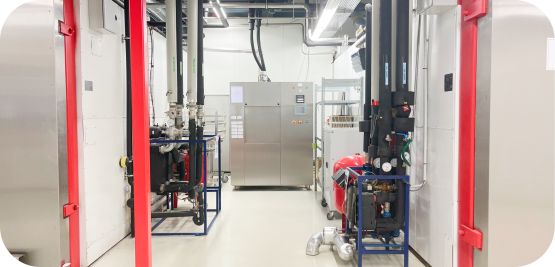(Download: Steam Sterilization Technology at Medistri in PDF by Medistri)
Steam sterilization is one of the most widely used and dependable methods for achieving sterility in healthcare. It works by using saturated steam under pressure at high temperatures to inactivate microorganisms, ensuring medical devices are safe for later use.
At Medistri, our steam sterilization technology is built around modern autoclaves with advanced monitoring and control systems. This allows us to provide precise, reliable, and reproducible sterilization cycles tailored to the specific requirements of your medical devices.
The Science of Steam Sterilization
The principle behind steam sterilization is simple yet powerful: moist heat denatures and coagulates the proteins of microorganisms, leading to their inactivation. Because steam transfers heat more efficiently than dry air, sterilization can be achieved at lower temperatures and in shorter exposure times. This makes the method highly effective against bacteria, spores, fungi, unicellular eukaryotic organisms, and other biological agents.
The Phases of a Steam Sterilization Cycle
Every cycle follows a controlled sequence to ensure that steam reaches all surfaces of the load:
- Pre-Conditioning: During this phase, the air is removed from the chamber and the load is humidified by means of alternating vacuum and pressure pulses.
- Exposure: During this phase, the chamber temperature is raised to and held at the pre-validated sterilizing temperatures for the per-validated exposure duration.
- Post-Conditioning: During this phase, solid loads are cooled and dried or liquid loads are cooled. The chamber is brought to atmospheric levels.
Advantages from a Technological Perspective
From a technology standpoint, steam sterilization remains highly relevant:
- Efficient: Rapid heat transfer leads to shorter exposure times.
- Reliable: Mechanical systems ensure reproducibility of each cycle.
- Versatile: Suitable for instruments, textiles, and certain heat- and moisture-resistant liquids or product types.
Technology Components
The precision of steam sterilization depends on the design and functionality of the equipment:
- Autoclaves: Pressure systems designed to maintain controlled conditions of temperature, pressure, and steam distribution.
- Steam Generation: Steam is produced to maximize heat transfer and eliminate cold spots.
- Monitoring Systems: Integrated sensors record and display temperature and pressure conditions in real time, ensuring consistency throughout the cycle.
Medistri’s Infrastructure
Our steam sterilization infrastructure is fully certified according to ISO 17665. With a modern autoclave and advanced cycle control, we can design custom sterilization processes that match the thermal and material requirements of your products. By studying critical parameters, our team ensures sterility is achieved without compromising product integrity.
Learn more about Medistri’s Steam Sterilization Technology on our website here or contact our team at contact@medistri.com.
— The Medistri Team
#Medistri
FAQ
1. What makes steam sterilization a dependable technology?
Steam sterilization relies on moist heat transfer, which efficiently denatures and coagulates microbial proteins. Because steam distributes heat uniformly under controlled pressure and temperature, the process ensures consistent and reproducible sterilization results.
2. Why is saturated steam preferred over dry heat for sterilization?
Saturated steam transfers heat more effectively than dry air, allowing sterilization at lower temperatures and shorter exposure times. This efficiency reduces energy consumption while maintaining complete microbial inactivation across the entire load.
3. How do autoclaves control and monitor the sterilization process?
Modern autoclaves regulate chamber pressure, temperature, and steam flow using automated control systems and integrated sensors. These devices record data in real time, ensuring each phase—pre-conditioning, exposure, and post-conditioning—operates within validated parameters.
4. When is it necessary to customize steam sterilization cycles?
Custom cycles are developed when product materials or geometries require specific exposure times or temperature profiles. Adjusting parameters such as pressure ramping, drying duration, or steam quality helps maintain sterility while preserving product integrity.
5. How does Medistri’s technology ensure precise and traceable steam sterilization?
Medistri’s ISO 17665–certified systems combine high-performance autoclaves with digital monitoring and data logging. These technologies allow precise control of cycle parameters and provide complete traceability, supporting validation and regulatory compliance.
